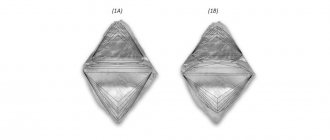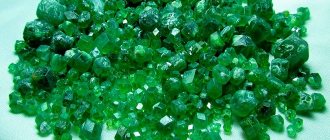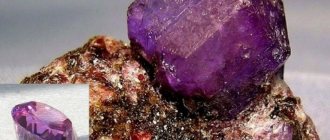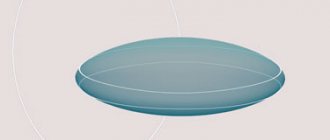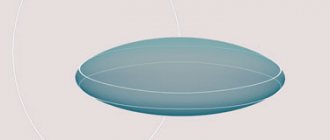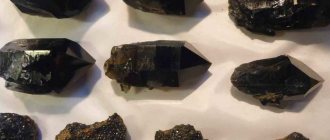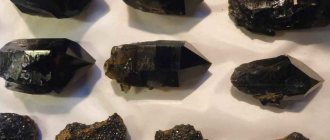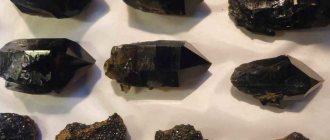Stones are cut to give them a certain shape, to emphasize the shine and play of light. A high-quality cut prevents rays from passing through - they are refracted in the edges of transparent and translucent stones and come back out. First, a scheme is created and thought through, taking into account the shape of the stone, the number, size and location of the edges and angles between the edges. The stones are then cut and polished.
There are about 250 varieties of cuts in jewelry. They depend not only on the taste preferences of jewelers, but also on the physical and optical characteristics of the stones. During the cutting process, it is important to preserve the weight of the stone and its natural advantages. Cutting can be divided into three large groups: smooth , faceted and mixed .
What is a diamond cut?
Cutting is the process of giving a shape to a diamond, which can highlight its noble color and remove natural defects, giving a glow to the gemstone.
Diamonds are cut by hand. This process is painstaking and thorough, and the quality of the cut and the further fate of the stone directly depend not only on the quality of the diamond, but also on the skill of the cutting specialist. The type, shape and cutting method of each crystal is selected depending on its size, weight, color characteristics and purity. The main objective of the diamond cutting process is to maintain its carat weight, and then to balance the clarity (presence of defects) and color of the diamond.
Smooth cut
Although formally it is classified as cutting, in essence it is polishing. The stone processed in this way has no edges, only a polished surface.
Cabochon (from the French caboche - “head” or “nail with a wide and round head”) is the most famous type of smooth cut. The cabochon is considered one of the first, and therefore the oldest, cuts. Honed stone usually has a flat bottom and a smooth, convex dome. Most often it is made in the shape of a circle or oval, although other shapes are also found: rectangle, rhombus, heart, drop, boat, crescent.
Cabochon cutting is used for opaque and translucent stones, as well as for stones with various optical effects (asterism, iridescence, opalescence, cat's eye). This is how jade, turquoise, amber, malachite, lapis lazuli, serpentine, onyx, opal, tugtupite, and sometimes sapphires, rubies and other stones are processed. This cutting method is not very complicated, and the quality of the source material does not play a big role.
Different types of cabochons are used for different tasks and stones. Opaque stones with a colored surface are cut into a single cabochon, which has a flat base and a convex top. For stones with internal defects, the shape of a double (lentil) cabochon, in which both sides are convex, is suitable. Dark stones are often cut into hollow cabochons with a concave base. There is also a tall cabochon with a very convex top and a flat one that looks like a frozen drop of candle wax.
Ball is another smooth cut option. Semi-precious and ornamental stones are processed in this way: aventurine, agate, amethyst, quartz, malachite, onyx, jasper.
Diamond, step and mixed cuts
Brilliant cut is a method of diamond processing in which the arrangement and number of facets give the stone maximum brilliance. This is a perfectly calibrated diamond shape, revealing its ability to reflect and refract light. For example, the classic round cut of a gemstone is a brilliant cut. Such a stone must have 57 facets.
A step cut is characterized by a strictly parallel arrangement of edges, which means the shape of the stone will be square or rectangular (very rarely, trapezoidal). This cut of the diamond does not add much brilliance or play of light, but favorably emphasizes the purity, transparency and depth of color of the stone. The most common step cut forms are emerald and baguette.
The mixed cut combines the features of both brilliant and step cuts. It is used when it is necessary to maintain the maximum weight of a gemstone, while emphasizing its color and quality characteristics. The most attractive and popular shape of this cut is the princess.
All non-classical round cut diamonds are called fancy. These include pear, heart, oval, marquise, cushion.
Faceted cut
The most diverse type of cut is faceted or beveled (from the French facette - “edge”). As the name suggests, this treatment creates many edges on the surface of the stone. Faceted cutting is used when working with transparent stones: it brings out their shine, enhances color and emphasizes light effects.
To understand the features of different facet cutting options, you need to understand the anatomy of a faceted stone.
Scheme 1: structure of a cut stone
The upper and lower parts of the stone are separated by a thin belt - a girdle. Usually the frame is fixed on it. The upper part, located above the girdle, is called the crown. There is a platform on it - a flat top face, the largest face of the stone. The lower part, located under the girdle, is called the pavilion. And the point of convergence of the edges of the pavilion at the very bottom is a culet; it can be in the form of a spike, a small horizontal edge or a line.
The faceted cut is divided into two types: classic or round brilliant , and fancy .
Circle
The circle cut has 57 facets (the generally accepted designation is Kr 57). This is perhaps the most popular diamond shape today.
It is designed specifically to maximize the shine of the stone. However, small defects and color tints in round diamonds will be less noticeable compared to stones of other shapes.
Many buyers prefer round diamonds, deservedly considering them classics.
Nowadays you can find round-cut diamonds with 17 facets (indicated on the product tag as Kr 17). In this way, small diamonds with a diameter of 0.7 to 1.2 mm are cut, which are attached as accompanying large or medium-sized diamonds, or in the form of diamond “sprinkling”, when the surface of the jewelry is as if strewn with small stones, as well as in diamond “paths” . The 17-facet circle cut allows you to maintain a balance between the brilliance and price of the diamond.
General rules for cutting stones
Several of the first cutting techniques appeared in the 19th century; it was then that jewelers decided on the standards of the techniques. In addition, fantasy varieties appeared.
It depends on the type of cut:
- The cost of a diamond. Always a complex cut with a large number of facets will cost more than standard cutting methods.
- The appearance and brilliance of a diamond. With the help of cutting, you can hide the defects of the stone and its unevenness. But this can only be achieved if the jeweler is highly skilled.
Often, diamond cutting is done ineptly, then the stone is considered damaged and is sold cheaper. The edges should be smooth and refract light in such a way that, looking through the stone at the sun, you can see the rays from the edges directed to one point. In this case, the refracted ray has the colors of a rainbow.
The first geometric calculations were carried out by Marcel Tolkowsky: it was he who determined the parameters of an ideal round diamond, which is now a common process technique. Such a stone has 57 or occasionally 58 facets. This can be done by a jeweler using the following techniques: Tolkowsky, Johnson and Roech, Eppler and the Scandinavian diamond cut.
As a result, the diamond has the following parts:
- crown - the upper part of the stone with a platform;
- pavilion - cone-shaped lower part;
- calleta - the top of a stone;
- girdle - the part between the crown and the pavilion.
Moreover, jewelers calculate the parameters of each of them, and if they do not coincide with the standards, then the cut is incorrect. But such methods are used only in standard cases.
Radiant
The radiant cut is always a rectangular or square shape with slightly truncated corners. This cut is also a brilliant cut; it combines the best qualities of the “princess” and “emerald” shapes.
“Radiant” refers to a mixed type of cut and has high brilliance levels of the diamond, and also favorably emphasizes the shade of the gemstone. Fancy diamonds are cut in this form, which allows their color to be conveyed as brightly as possible. Such stones are very rare to find, and due to their strict shape, they are more often chosen by men.
Types of cuts.
The original cut is usually referred to as a "brilliant cushion". This shape was created before the round cut became popular, and for a long time cushion diamonds were the standard.
The classic cushion cut is also called the "old mine" cut and is sometimes referred to as the "antique cushion".
It's worth noting that the original design has been modified over time to improve the shine.
While older versions of this cut had smaller lands, larger facets, and larger culets, newer variations have “refined” these characteristics to increase shine.
Despite this, some still use the terms "old mine" and "antique" when referring to the modern cushion cut.
The modified diamond differs from the classic version in the number and shape of the facets on the pavilion (i.e. its lower part). (From above, the classic and modified stone look more or less the same.)
There are various variations of recuts and the main reasons they were created were to increase brilliance and reduce weight.
Qualitative characteristics.
Here are the most important quality characteristics of cushion diamonds:
Purity
How pure this diamond appears depends on its sparkle and brilliance. Therefore, crushed ice diamonds tend to hide inclusions better because they have more sparkle.
"Short" diamonds, on the other hand, can make certain imperfections significantly visible due to the lower luster of these stones.
Stones of clarity grades lower than SI1 or SI2 are likely to show obvious inclusions.
Color
Because cushion diamonds have a relatively low luster compared to round stones, the yellow tints in them are more easily visible.
In general, to find a stone that appears colorless to the naked eye, look for a color grade of at least G or H.
Cut
These diamonds have no specific rules regarding ideal proportions.
Most cushion diamonds have a table length of approximately 55-60% of the belt and a depth of approximately 60%.
As a rule of thumb, avoid diamonds that are too shallow or too deep and try to find a stone that has a table to depth ratio of no more than 70%.
Comparison of diamond cuts.
When choosing a diamond, one of the characteristics you should pay particular attention to is the cut. And for good reason: this characteristic significantly affects how bright the stone will shine.
The classic is a round brilliant cut, and all others that are not round are often called "fancy".
Each diamond cut can be assessed on a variety of parameters such as the depth of the stone, its width, the area of its apex, and many other proportions.
The most comprehensive cut grading system that has been created is the one used to grade the round, the most popular cut.
How is a round brilliant cut graded?
It is graded according to how close its proportions are to the so-called “ideal cut”, i.e. treatments with dimensions that allow the diamond to reflect light in a way that maximizes its brilliance.
Comparison of round diamond cut.
There are many parameters that are taken into account when assigning a grade to a certain diamond, but the most important proportions that determine the quality of round cuts are table diameter, crown height and pavilion depth.
Table diameter is a measure that refers to the diameter of the main surface of the stone, expressed as a percentage of the diamond's girdle (edge). For most top quality diamonds this proportion is in the 53%-57% range.
The height of the crown refers to the distance from the top of the diamond to its band. The most popular ideal cut standards in use today recommend that this measure be between 14% and 16%.
The pavilion depth is the height of the bottom of the diamond, from its waist to its bottom. In well-cut stones, the pavilion makes up approximately 43% of the girdle.
